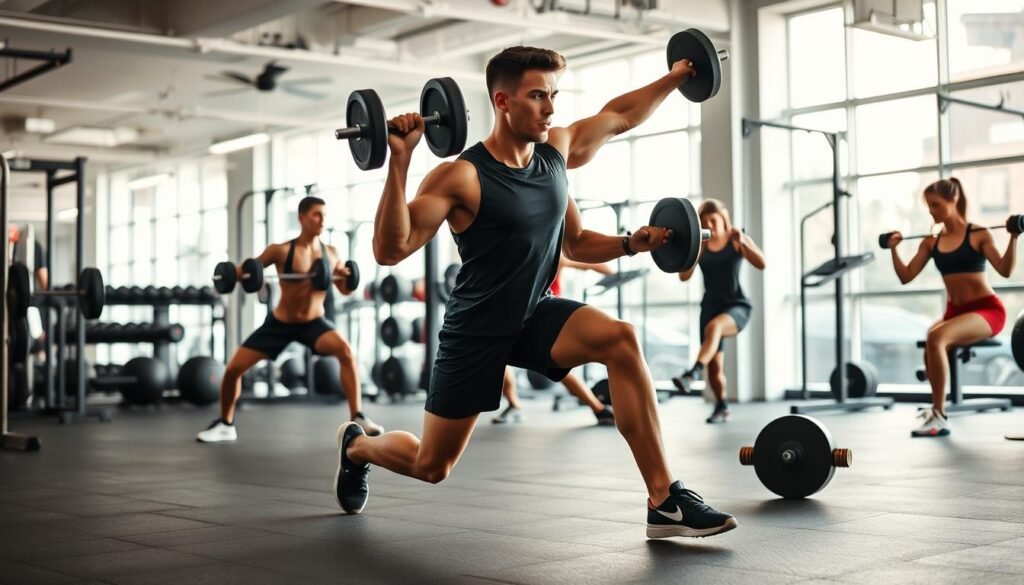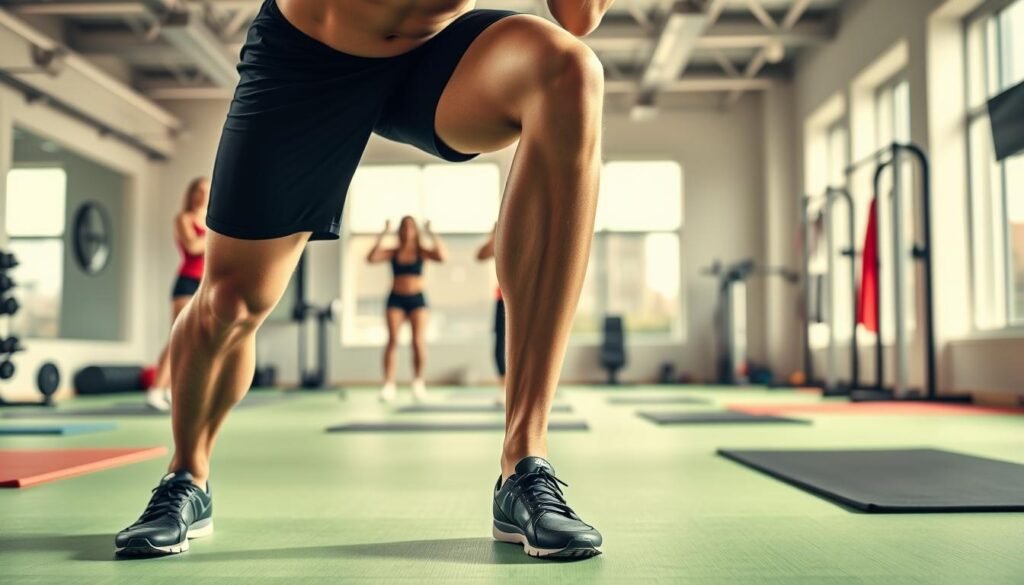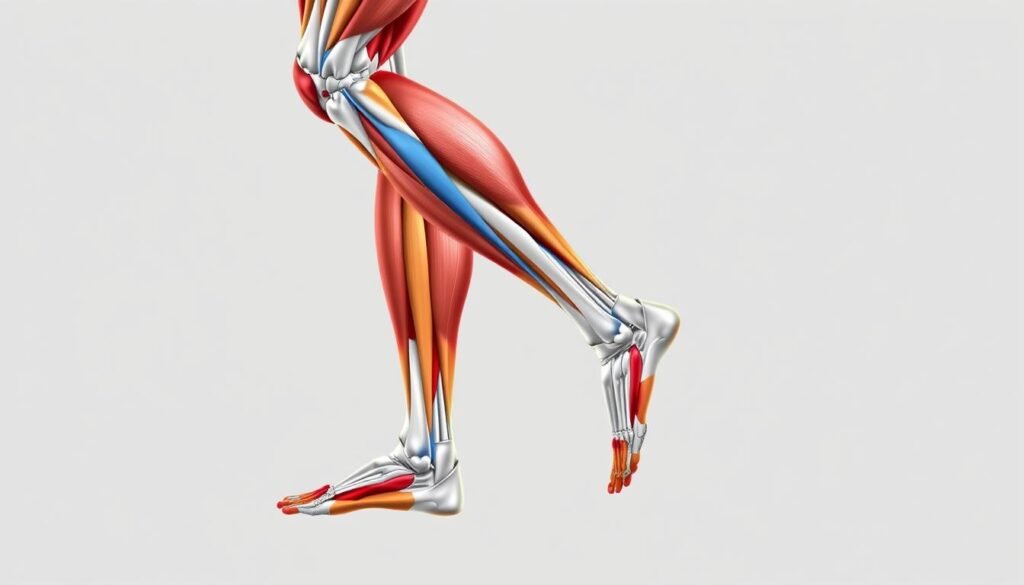Did you know the quadriceps muscles have four distinct parts? These include the Vastus Medialis and Rectus Femoris. This shows how complex our leg muscles are. It also highlights why we need to focus on them in our workouts. The right exercises can ease pain, boost strength, and better endurance. Doing so changes how we handle daily tasks and improves athletic skills.
Readers will learn here about great exercises for heavy legs. These workouts don’t just make leg muscles stronger. They also better overall fitness. By adding leg exercises like squats, deadlifts, and lunges, one can see notable improvements. Strong leg muscles are key. They help us walk, run, and play sports. Keep reading for advice on creating the best leg workout for top-notch results!
Key Takeaways
- Understanding leg anatomy helps in selecting targeted leg exercises.
- Squats and lunges are fundamental for building leg strength and functionality.
- Warm-up and cooldown practices are critical to prevent injuries during workouts.
- Consistent leg training can improve performance metrics like speed and agility.
- Incorporating all muscle groups is essential for a balanced and effective leg workout.
- Utilizing household items can provide alternatives for at-home leg workouts.
Understanding Heavy Legs
Understanding heavy legs is about knowing the key reasons behind leg tiredness. Things like poor blood flow, not enough exercise, and some health issues can make muscles stiff and tired. For sports people, feeling heaviness in the legs is a usual problem. This is true for runners and cyclists who push their limits.
Heavy legs can come from chronic venous insufficiency. This happens with too much standing causing tiredness and swelling. Another cause is peripheral arterial disease. It’s more common in people over 40 and reduces blood flow, making legs feel heavy.
It’s important to consider how our lifestyle affects our legs. Smoking, eating poorly, and not drinking enough water can make legs feel heavier. Some medicines might also affect how our muscles and blood flow work. It’s key to watch for signs and take them seriously. Talking to a doctor is key for the right diagnosis and help. Tips for relief include boosting circulation and doing strength workouts for the legs. Discover more ways to prevent heavy legs here.
Being pregnant or having conditions like lipedema can cause a lot of discomfort. Staying active, keeping a healthy weight, and staying hydrated are very important. Not getting enough important nutrients, like iron, can slow down muscle recovery. This makes legs feel heavy. If you’re feeling tired, look at your health and daily habits.
To better understand heavy legs, look into resources that explain the symptoms and root causes. Also, learn about unexplained bruises and tiredness. Click here for further information.
The Importance of Leg Workouts
Leg workouts are much more than just making your legs look good. They are key for better movement and sports play. By working out your legs, you can avoid injuries and handle conditions like arthritis better.
Adding leg exercises to your routine releases important hormones. These are cortisol, testosterone, and human growth hormone. They help your muscles grow. It’s also crucial for making sure your body is balanced and strong on both sides.
Leg exercises do wonders for your fitness. They build muscle, tone your body, and help you stay fit. Skipping leg day can lead to less stability and movement. So, it’s important to keep leg workouts in your routine.
Talking to a fitness pro can make your workout plan better. It will include leg strength and exercises for your heart, balance, and flexibility. Doing leg exercises like squats and deadlifts has many benefits. It helps burn calories and lowers injury risks.

| Leg Workout Benefits | Impact on Health |
|---|---|
| Muscle Building | Prevents injuries |
| Toning | Manages chronic conditions |
| Improved Balance | Enhances athletic performance |
| Calorie Burning | Promotes weight loss |
| Core Strengthening | Improves mobility and stability |
Exercise Recommendations for Heavy Legs
Do you want to improve your life by dealing with heavy legs? Adding exercises specific to heavy legs into your workout regimen can make a big difference. You will see an increase in blood flow, less tiredness, and stronger legs. It’s key to do both muscle-building exercises and stretches for the best outcome.
Strengthening Exercises
Strengthening your legs is key to reducing the feeling of heaviness. By doing squats, lunges, and deadlifts, you work out the big muscles in your legs. This helps with muscle restoration and endurance. Making sure you perform these movements correctly is vital to avoid injuries and reap the most benefits. Here’s a list of strengthening exercises to try:
- Squats: Perfect for working your quadriceps, hamstrings, and glutes.
- Lunges: They are great for balance and efficiently exercising your legs.
- Deadlifts: These are awesome for strengthening your back, glutes, and legs.
Try to do these exercises at least two times a week. Doing so will significantly boost your leg strength and stamina.
Stretching for Relief
Stretching is just as crucial as strengthening exercises for relieving heavy legs. It boosts flexibility and blood flow, helping lessen the weight you feel in your legs. Some stretches we suggest include:
- Hamstring stretches: They increase flexibility in the back of your legs.
- Quadriceps stretches: These help ease the tightness in the front of your legs.
Adding these stretches after your workouts aids in recovery and prevents injuries. A consistent routine of both strengthening and stretching exercises designed for heavy legs will offer lasting improvements in how you move and feel.

| Exercise Type | Benefits | Frequency |
|---|---|---|
| Strengthening Exercises | Builds muscle, enhances endurance | At least 2 times per week |
| Leg Stretches | Improves flexibility, aids recovery | After every workout session |
Key Muscle Groups Targeted in Leg Workouts
It’s crucial to know the main muscle groups in leg workouts to maximize your training. Working these muscles improves strength, stability, and endurance. Let’s look at the important ones: quadriceps, hamstrings, and calves.
Quadriceps
The quadriceps are in the front of your thigh and have four parts. They are very powerful and help extend the knee. This is essential for running, jumping, and squatting. Focusing on the quadriceps boosts athletic ability and aids in daily activities.
Hamstrings
The hamstrings are behind your thigh and include the Biceps Femoris and Semitendinosus. They’re key for bending your knee and moving your hip back. Strong hamstrings reduce injury risks, especially in high-impact sports. Good workouts should target the hamstrings for better strength and function.
Calves and Other Important Muscles
The calves include the Gastrocnemius and Soleus muscles, at the back of the lower leg. These muscles are important for walking, running, and jumping. Workouts should also target the calves for improved leg strength. Don’t forget the adductors and abductors on the inner and outer thighs. They’re important for stability and movement. Including these muscles in workouts reduces tiredness and boosts health.

Effective Leg Exercises for Strength and Endurance
Adding leg exercises to your workout makes you stronger and improves endurance. Moves like squats, lunges, deadlifts, and calf raises are key. They work many muscles at once, making your lower body strong. These moves also make you faster, more explosive, and improve muscle coordination.
Squats
Squats focus on your quadriceps, hamstrings, and glutes. To squat, keep your feet apart and lower yourself, keeping your chest lifted. Do this for three sets of 8-12 reps. Trying variations like goblet or barbell squats helps increase resistance. This boosts your strength and endurance more.
Lunges
Lunges target the whole lower body. Step forward and bend your knees to about 90 degrees, then switch legs. Mixing in different types like reverse or side lunges works more muscles. Aim to do three sets of 10 reps for each leg.
Deadlifts
Deadlifts focus on the backside of your body, like your hamstrings and lower back. Start with your feet apart, lift a weight while keeping your back straight. Increase weight over time, doing three sets of 6-10 reps. Deadlifts not only build strength but also improve your stability and posture.
Calf Raises
Calf raises target your calf muscles. Stand with feet apart, lift your heels, then lower them. Do three sets of 12-15 reps. Resistance bands can add variety to this exercise.
Including these leg exercises weekly improves how you move and perform athletically. Start and end with proper warm-up and cool-downs to get the most benefit and prevent injuries. For basic exercise tips, check out this resource. To see the benefits of flexibility, like less mental fatigue and better performance, read this guide.
Integrating Leg Stretches into Your Routine
Adding leg stretches to your workout is key for better flexibility and muscle recovery. Stretching eases muscle tightness and gets the body ready for harder exercise. Stretch the main muscle groups 2 to 3 days a week. Each stretch should last about 30 seconds. Do each stretch 2 to 4 times for each side.
Stretches like the calf muscle, hamstring, quadriceps, hip flexors, and lower back are common. Hamstring stretches help with tightness from sitting too long. Quadriceps stretches are good against stiffness from running or biking. Remember to stretch tight calf muscles, especially if you often wear high-heels. They’re a big part of any leg stretch routine.
Don’t bounce during stretches. Instead, breathe deeply through each position for the best results. Balance exercises, like standing on one leg, can also lower fall risks. Start with a 5 to 10-minute light warm-up. This way, your muscles are ready to stretch and become more flexible over time.
People with conditions like osteoporosis should talk to a doctor before starting stretches. Avoid stretches like knee-to-chest for them. As you get more flexible, try deeper stretches with the help of walls or door frames. Making leg stretches part of your daily activities helps ease muscle stiffness. It also improves mobility, an essential part of fitness.
| Stretch Type | Targeted Muscle Groups | Recommended Frequency | Hold Duration |
|---|---|---|---|
| Hamstring Stretch | Hamstrings | 2-3 times a week | 30 seconds |
| Quadriceps Stretch | Quadriceps | 2-3 times a week | 30 seconds |
| Calf Stretch | Calves | 2-3 times a week | 30 seconds |
| Hip Flexor Stretch | Hip Flexors | 2-3 times a week | 30 seconds |
| Lower Back Stretch | Lower Back Muscles | 2-3 times a week | 30 seconds |
Tips for Reducing Leg Fatigue
Standing a lot or doing intense workouts can make legs tired. Warming up properly and cooling down right are key. They keep legs healthy and stop them from getting too tired.
Proper Warm-up Techniques
Warming up gets muscles ready for exercise. It improves blood flow and makes you more limber. This helps a lot in keeping leg tiredness away.
Good ways to warm up include:
- Dynamic stretches, like moving your legs and arms to wake up muscles.
- Light cardio, such as jogging on spot or fast walking, to get your heart going.
- Bodyweight exercises, like squats or lunges, that get muscles ready for tougher stuff.
Cool Down and Recovery
Doing things to cool down after exercising helps with leg tiredness. It stops muscles from hurting and helps them recover. Here are some cool down tips:
- Gentle stretching makes you more flexible and eases muscle tightness.
- Slow walking for a few minutes helps lower your heart rate and keeps blood moving.
- Rest and elevation of your legs, for half an hour, helps with blood flow and lowers swelling.
Using smart warm-up and cool-down methods really helps with leg tiredness. They boost your performance and keep your legs in good shape. Knowing and using these tips means you can do more, with less pain and more stamina.
Creating a Balanced Leg Workout Plan
Creating a good leg workout plan helps you work all key muscle groups, boosting strength and flexibility. A well-planned weekly routine offers a range of exercises, making workouts interesting. Staying consistent is key to seeing better fitness results over time.
Sample Weekly Workout Schedule
Here’s a basic plan for organizing leg workouts during the week:
| Day | Workout Focus | Exercises |
|---|---|---|
| Monday | Strength Training | Barbell squats, Romanian deadlifts, Lunges |
| Wednesday | Hypertrophy | Leg press, Bulgarian split-squats, Lying leg curls |
| Friday | Endurance Training | Bodyweight squats, Step-ups, Calf raises |
Maintaining Consistency for Better Results
To reach your fitness goals, stick to a solid workout plan. Exercise those legs at least twice a week. Make sure to rest 48 hours between workouts. Change up the exercises and reps to avoid hitting a plateau.
Some prefer mixing full body and split routines. With patience and dedication, you’ll improve and see the benefits of your leg workout plan.
Conclusion
Knowing how to ease heavy legs with exercises is key for well-being. This article shared the value of working on specific muscles like the quadriceps, hamstrings, and calves. Doing both strengthening and stretching exercises helps with muscle strength, flexibility, and blood flow.
This reduces issues like restless legs syndrome and chronic venous insufficiency. Following the expert tips can improve leg health and how well they work. Regular exercises that put weight on your legs keep your bones healthy. This stops problems that come with getting older, like osteoporosis and losing muscle.
Start your journey to healthier legs by doing these exercises regularly. This guide encourages you to use these strategies for strength and a chance at an active and happy life even as you age.